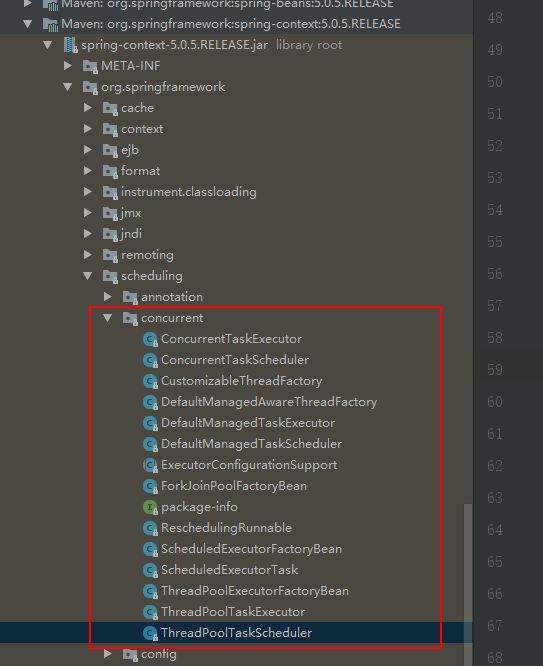之前写了很多资料,不过都是自己整理没有公开,如果大家感兴趣可以看下我在码云整理的资料
不过上面的资料都是随手记得,没有很好地归类梳理,有空会慢慢整理放到博客中。只有不断梳理和整理才能不断地加深记忆和提高
Spring 中使用线程池
org.springframework.scheduling.concurrent
ThreadPoolTaskExecutor
public class ThreadPoolTaskExecutor extends ExecutorConfigurationSupport
implements AsyncListenableTaskExecutor, SchedulingTaskExecutor
我们可以看到继承了ExecutorConfigurationSupport类
public abstract class ExecutorConfigurationSupport extends CustomizableThreadFactory
implements BeanNameAware, InitializingBean, DisposableBean
实现BeanNameAware, InitializingBean, DisposableBean这三个接口主要是做一些初始化和销毁资源处理操作
初始化操作:
/**
* Calls {@code initialize()} after the container applied all property values.
* @see #initialize()
*/
@Override
public void afterPropertiesSet() {
initialize();
}
/**
* Set up the ExecutorService.
*/
public void initialize() {
if (logger.isInfoEnabled()) {
logger.info("Initializing ExecutorService " + (this.beanName != null ? " '" + this.beanName + "'" : ""));
}
if (!this.threadNamePrefixSet && this.beanName != null) {
setThreadNamePrefix(this.beanName + "-");
}
this.executor = initializeExecutor(this.threadFactory, this.rejectedExecutionHandler);
}
/**
* Create the target {@link java.util.concurrent.ExecutorService} instance.
* Called by {@code afterPropertiesSet}.
* @param threadFactory the ThreadFactory to use
* @param rejectedExecutionHandler the RejectedExecutionHandler to use
* @return a new ExecutorService instance
* @see #afterPropertiesSet()
*/
protected abstract ExecutorService initializeExecutor(
ThreadFactory threadFactory, RejectedExecutionHandler rejectedExecutionHandler);
有一个抽象方法,用来初始化executor
在ThreadPoolTaskExecutor中的实现:
@Override
protected ExecutorService initializeExecutor(
ThreadFactory threadFactory, RejectedExecutionHandler rejectedExecutionHandler) {
BlockingQueue<Runnable> queue = createQueue(this.queueCapacity);
ThreadPoolExecutor executor;
if (this.taskDecorator != null) {
executor = new ThreadPoolExecutor(
this.corePoolSize, this.maxPoolSize, this.keepAliveSeconds, TimeUnit.SECONDS,
queue, threadFactory, rejectedExecutionHandler) {
@Override
public void execute(Runnable command) {
Runnable decorated = taskDecorator.decorate(command);
if (decorated != command) {
decoratedTaskMap.put(decorated, command);
}
super.execute(decorated);
}
};
}
else {
executor = new ThreadPoolExecutor(
this.corePoolSize, this.maxPoolSize, this.keepAliveSeconds, TimeUnit.SECONDS,
queue, threadFactory, rejectedExecutionHandler);
}
if (this.allowCoreThreadTimeOut) {
executor.allowCoreThreadTimeOut(true);
}
this.threadPoolExecutor = executor;
return executor;
}
在这里我们可以看到是new一个ThreadPoolExecutor
销毁操作
@Override
public void destroy() {
shutdown();
}
/**
* Perform a shutdown on the underlying ExecutorService.
* @see java.util.concurrent.ExecutorService#shutdown()
* @see java.util.concurrent.ExecutorService#shutdownNow()
*/
public void shutdown() {
if (logger.isInfoEnabled()) {
logger.info("Shutting down ExecutorService" + (this.beanName != null ? " '" + this.beanName + "'" : ""));
}
if (this.executor != null) {
if (this.waitForTasksToCompleteOnShutdown) {
this.executor.shutdown();
}
else {
for (Runnable remainingTask : this.executor.shutdownNow()) {
cancelRemainingTask(remainingTask);
}
}
awaitTerminationIfNecessary(this.executor);
}
}
我们可以看到主要是用了ExecutorService的shutdown做一些资源的处理
继承CustomizableThreadFactory类,自定义new thread name的规则
public CustomizableThreadFactory(String threadNamePrefix) {
super(threadNamePrefix);
}
@Override
public Thread newThread(Runnable runnable) {
return createThread(runnable);
}
具体的线程执行
@Override
public void execute(Runnable task) {
Executor executor = getThreadPoolExecutor();
try {
executor.execute(task);
}
catch (RejectedExecutionException ex) {
throw new TaskRejectedException("Executor [" + executor + "] did not accept task: " + task, ex);
}
}
@Override
public void execute(Runnable task, long startTimeout) {
execute(task);
}
@Override
public Future<?> submit(Runnable task) {
ExecutorService executor = getThreadPoolExecutor();
try {
return executor.submit(task);
}
catch (RejectedExecutionException ex) {
throw new TaskRejectedException("Executor [" + executor + "] did not accept task: " + task, ex);
}
}
@Override
public <T> Future<T> submit(Callable<T> task) {
ExecutorService executor = getThreadPoolExecutor();
try {
return executor.submit(task);
}
catch (RejectedExecutionException ex) {
throw new TaskRejectedException("Executor [" + executor + "] did not accept task: " + task, ex);
}
}
总结
建议在Spring项目中使用ThreadPoolTaskExecutor,对ThreadPoolExecutor做了很多封装,使用简单。对ThreadFactory实现
在非Spring项目中建议使用ThreadPoolExecutor,可以加深对线程池的了解
下面是org.springframework.scheduling.concurrent包下对并发处理的一些实现,有空的时候可以多去了解下
